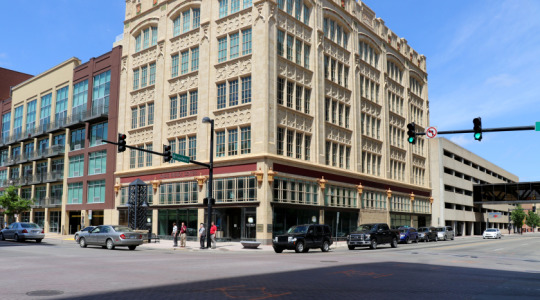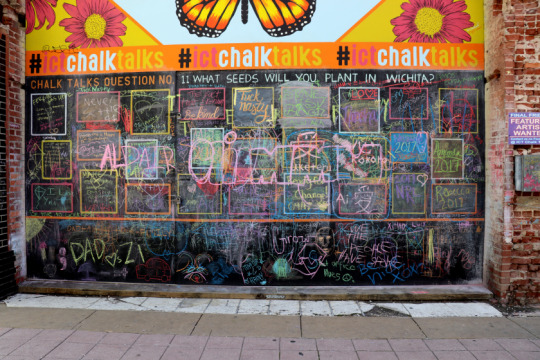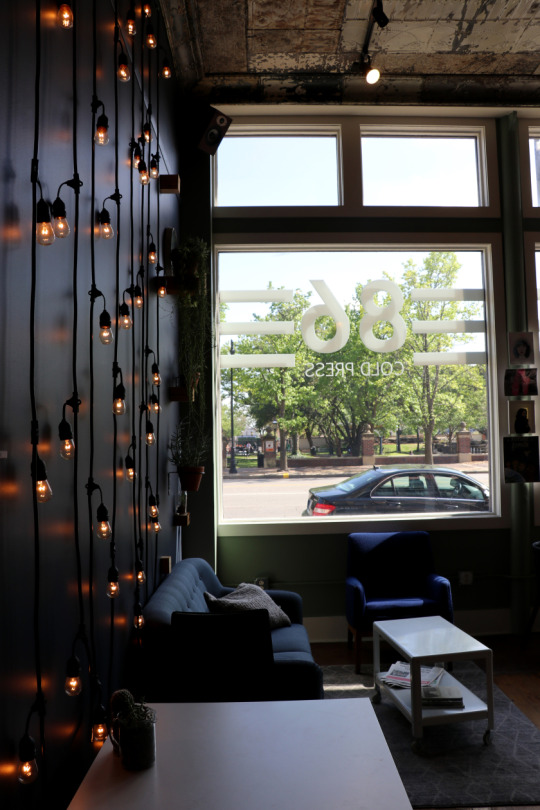#dockum drug store sit in
Explore tagged Tumblr posts
Text

The Dockum Drug Store Sit-Ins occurred in Wichita, Kansas (July 19 and August 11, 1958). Ronald W. Walters, a local college student who was at the time president of the Wichita NAACP Youth Council, organized the sit-ins at the Dockum Drug Store along with his cousin, Carol Parks-Hahn, who was treasurer of the Council. The sit-ins protested the Dockum policies that barred African Americans from being served at its lunch counter.
On July 19, 1958, Walters, Parks-Hahn, and ten other students entered the Dockum Drug Store until all the lunch counter seats were taken. He ordered a Coca-Cola from a waitress, who was about to serve it to her but pulled it back when she realized that the store policy banned service to African Americans. The students told the waitress they intended to stay until they could be served. The waitress closed the Blacks-only fountain, leaving the whites-only fountain open. When the store closed for the night, the students left.
The student protestors returned to the lunch counter, where they sat for an hour without getting service that day. As the second sit-in occurred at Dockum, 20 White segregationists began taunting and threatening the protestors.
The students continued to come in day after day and sit at the lunch counters. White college students from Wichita State University joined them. The Eagle and the Beacon refused to publish information about the sit-ins, and the local Black-owned newspapers, the Enlightener and the Mid-West News-Press, provided regular accounts to their readers.
The Wichita branch of the NAACP applauded the students’ efforts but did not participate because the national office did not sanction sit-ins. On August 11, 1958, the store manager ended the protests by saying, “Serve them. I’m losing too much money.” Chester A. Lewis, attorney, and head of the Wichita NAACP, called Walter Heiger, the vice president of the Dockum Drugstore Chain, to confirm the new integration policy. Heiger instructed all Dockum stores to provide service to people of all races. The Dockum Drug Store Chain was officially desegregated. #africanhistory365 #africanexcellence
2 notes
·
View notes
Text

#OtD 11 Aug 1958 young African Americans in Wichita, Kansas won a key early sit-in protest against segregated lunch counters at Dockums Drug Store. They confronted bosses, police and racists for 23 days until they won. More info in this short history: libcom.org/history/wichit…
0 notes
Text
NJ Ayuk on How the Civil Rights Movements Can Influence Energy Policy
As the chairman of the Africa Energy Chamber, NJ Ayuk works to piece together large-scale deals worth trillions of dollars. But his concerns aren’t financial. The most important part of good energy deals, he said, concerns people.
That may sound like a boilerplate platitude pushed by corporate public relations experts, but NJ Ayuk has the background and track record to back it up. From his humble beginnings as one of six children born to a single mother in Cameroon to his education at the feet of icons of the American civil rights movement to his work on international energy deals, his biography reflects his commitment to benefitting underserved people.
“I know what it’s like to be looked over for reasons that you cannot change,” he said. “My entire life, people have looked down on me for where I came from, or how I talk, or how much money my family had. And I was fortunate to have a family that never accepted those as excuses for not doing my best and trying my best. So I can’t help but believe that many people could be so much greater if they were just given more opportunities. I’ve seen it happen.”
NJ Ayuk draws inspiration from both his family and from the team of mentors he found when he attended college and law school in the United States. While attending the University of Maryland, Ayuk took a class with Dr. Ronald Walters, who had been president of the Wichita, Kansas, NAACP Youth Council and organized the famous sit-in at Dockum Drug Store.
Walters’ passion for justice and drive for change resonated with Ayuk. Like his protégée, Walters was born into a large family and suffered from exclusion early in life.
“Ron worked for the Rev. Jesse Jackson during his '84 and '88 campaigns, so he was an important and well-known person, and he really took me under his wings when I was a college student. It meant so much to see this person I respected and admired, who was known everywhere and had so much talent, to take an interest in me and encourage me to do great things,” NJ Ayuk said. “He really gave me a big, big shot at thinking and looking at life differently. I responded to how he talked about using the law to bring about change that truly helped people.”
Ron Walters not only encouraged NJ Ayuk to attend law school; he also espoused a people-centric philosophy that continues to guide how Ayuk thinks about the policies and deals he works on.
One critical component of the civil rights philosophy that undergirds NJ Ayuk’s work is how people can effect change even when they are disenfranchised, he said.
“I approach many policies and deals with the understanding that, in Africa, we’re going to have to be people that bring about the change we want to see,” he stated. “And I’m sorry to everybody that is hoping that the White House or some other house or organization is going to do it for us. It will have to come from our house, much like it did in the United States during the 1960s. The government has a role to play. It can assist us, but when you look at our energy situation and the energy crisis in South Africa, for example, we are in the dark. We're spending six to 10 hours a day in the dark in Africa. That is something that we can fix and we will have to fix. It will not be done for us by someone outside.”
That kind of mindset has led NJ Ayuk to advocate for African people to become beneficiaries of the money brought in by the natural resources of their homelands.
While Africa is home to vast amounts of fossil fuels, like oil and natural gas, most of the money made by selling and exporting energy hasn’t spread to all people equally. NJ Ayuk hopes to fix that. He believes the profits from new wells, drilling locations, and exports can help deliver electricity and opportunity to people across the continent.
“We have a chance to extend opportunities to Africans. Right now, there are 600 million people in Africa who do not have [electricity] in their homes. They live in the darkness, and they lose out on the abilities that other people have,” he said. “We can help students study at night. We can help small business owners. If we can get electricity into more communities and villages, we can greatly increase the kind of health care people can access. There are many, many ways that energy can help people. And not just getting energy into homes and businesses, but using the profits from energy sales to invest in education and opportunities for women and girls and people who have never had a shot.”
0 notes
Photo

On this day, 11 August 1958, civil rights activists in Wichita, Kansas won a key early successful sit-in protest against segregated lunch counters. Black students and young people sat at the counter in the Dockum's Drug Store in rotating shifts of 30 minutes to 2 hours, blocking sales and facing down police and racist harassment for 23 days until they won. After this victory, sit-ins spread rapidly across the Jim Crow states and desegregated many eateries. Learn more about Jim Crow laws, and life under them, in these books: https://shop.workingclasshistory.com/collections/books/david-pilgrim https://www.facebook.com/workingclasshistory/photos/a.296224173896073/2055342367984236/?type=3
147 notes
·
View notes
Photo

A newspaper clipping from the Aug. 7, 1958, issue of the Enlightener, a Black newspaper in Wichita shows the Dockum Drug Store lunch counter sit-in, one of the earliest in the United States.
Source: Wichita-Sedgwick County Historical Museum
67 notes
·
View notes
Text
Wichita students sit-in for US civil rights, 1958

Steven. | libcom.org | July 19th 2017
07.19.1958 Dockup-Drug-Store-newspaper-picture.jpg
A short history of the first successful sit-in protest of the civil rights movement in the Dockum Drug Store in Kansas.
read more
→ READ MORE ←
Get your Latest News From The Leftist Front on LeftPress.tk → Support Us On Patreon! ←
#leftpress#news#resistance#politics#Matthew Heck#NAACP#retail and food#USA#civil rights movement#Dockum Drug Store#Kansas#occupations#race#Wichita#Steven.#libcom.org#Wichita students sit-in for US civil rights#1958
1 note
·
View note
Text

Well over a year ago, I had the opportunity to attend a learning journey to Kansas’ largest city, Wichita, hosted by the Wichita Community Foundation. Kansas was the last place that I would have thought that I would’ve ended up for work, but my job has allowed me to reevaluate the way that I view cities around the world.

Wichita, once known as Cowtown, began as a trading post along the Chisholm Trail in the 1860’s. Prior to its development into a city, Wichita was inhabited by what Spanish explorer Francisco Vazquez de Coronado dubbed “Quivira,” or Wichita, people. The US purchased the land from the French via the Louisiana Purchase and it became part of the Kansas Territory in 1854.

Being along the Chisholm trail made the area a destination for cattle drivers traveling from Texas. The immigration that resulted because of this led to a speculative land boom and expanded the city. Several colleges came about, with one of the most notable being Wichita State University, which opened in 1886.
Fast forward to the 1920’s. The discovery of oil and natural gas led to a second economic boom and created the fortunes of oil moguls Archibald Derby and Fred C. Koch. Aviation and aircraft manufacturing developed, creating a third economic boom during World War II. They quickly became the “Air Capital of the World,” being the first city to mass produce commercial aircrafts. Growth slowed in the 70’s and then the city, along with local organizations, began working together to revitalize the city in the 2000’s. (Note: This is not a full historical overview. I’ve a provided link above for those that want to read a fuller history of Wichita.)

Those who know the history of Akron (my hometown) know that this is a similar timeline. Akron began as a pass-through area due to the canal and eventually a town cropped up around it. It went through economic booms due to the rubber industry and went into decline only for the local government, community members and area organizations to begin efforts to revitalize it.
Their current challenges reflect Akron’s, namely the need for more small businesses, lack of use of public spaces beyond special events, and the hurdle of reversing the trend of people moving away from the city centre. They’re not completely similar; in fact, Wichita has more than double the population that Akron has and their major industries and families continue to play an active role in its future. The largest employers in Wichita are still in aircraft manufacturing. But due to the similarities, I quickly felt at home and it made me want to learn more.

Geographically, the city is very flat with the large Arkansas River (host site for Wichita Riverfest) dividing the eastern and western parts of the city. Wichita’s history as one of the first organized lunch counter sit-ins (the Dockum Drug Store sit-ins) during the Civil Rights Movement appears to be relatively unknown to many. Sculptures tucked in a park off the main street tell the story of this important, but often forgotten time in our nation’s history. Student-led with little support from the area’s NAACP chapter, the protests lasted for a month before the owner finally allowed the black students to be served. But, as with the rest of the nation today, racial inequality is an ongoing problem.
The city’s complicated relationship with the Koch Brothers fascinates me. The Koch family has provided tens of millions of dollars to support area nonprofits in the arts, sciences, sports, and more. But they’ve also provided just as much money and influence on things less visible. The brothers are most often known around the nation as conservative mega-billionaires that have nearly unmatched power and influence.

During my trip, I got a chance to visit the WSU Innovation Campus makerspace facility, GoCreate, and it was incredibly inspiring and heavily funded by Koch. Open to the public through memberships, this facility is state-of-the-art, innovative, and community focused. They have spaces for woodworking, metal and welding, textiles, design (3D, graphic, etc), and electronics. There’s a co-working space, private rooms available for rent, mentorship opportunities, and classes to train people on the equipment and to better their projects, small businesses, etc. I’d be over the moon if we had something like that in my hometown.
The Positives
Flag: I think that my favorite thing about Wichita is their flag. Designed in 1937, it means freedom, happiness, and home. The Native American symbol for home sits in the center.
Public Art: Wichita has a lot of public art. My favorite is a collection of beautiful, interactive sculptures by Georgia Weber that stretches along Douglas Ave, commissioned by the DeVore Foundation. And I can’t mention public art without highlighting the Keeper of the Plains, a 44-foot tall statue at the meeting point of the Little and Big Arkansas rivers. It was created by Wichitan and Native American artist Blackbear Bosin.
Infrastructure: Unlike Akron, Wichita saved most of its old buildings. Small businesses have begun to pop up in downtown and development has started to grow.
Cost of Living: The cost of living in Wichita is well below the national average. A downtown 2-bedroom apartment will cost you around $1000 per month.
Industry Support: This is a city with deep roots in manufacturing that has stayed over time. The family of one of those businesses lives in the city and aids the city through financial support.
Engagement: From what I saw (because I was there for work), Wichita has a growing art scene full of diverse creatives who are engaged and ready to roll up their sleeves to make their community better. The Wichita Community Foundation has does some great work in supporting initiatives to get people engaging with others and public space. The ICT Pop-Up Urban Park is a prime example of that.

The Negatives
Downtown Living: Wichita struggles with getting people to live downtown and bridging that city/rural divide. I believe things are beginning to change, but it’s a common challenge with midsize cities.
Walkability and Public Transportation: The city’s walking, biking, and public transit could be improved. I checked into their WalkScore and TransitScore and they’re pretty low. This means that most errands need a car and there aren’t many bike lanes.
Industry Support: This one is a double-edged sword because that heavy investor in the city may have a lot of influence in the way the city takes shape. It could also leave the city vulnerable if they were to leave.

Overall, I enjoyed my time in Wichita and would love to go back to take a deeper dive into all that the city has to offer. Data USA, a website and visualization engine, has a deeper dive into Wichita’s story through public US Government data.
Have you been to Wichita? What are your thoughts?
Thanks for reading,
Travel Log: Wichita Well over a year ago, I had the opportunity to attend a learning journey to Kansas' largest city,
0 notes
Photo

July 19, 1958: Dockum Drug Store Sit-In A sit-in at a Woolworth lunch counter in Greensboro, North Carolina, in 1960 is often cited as the first civil rights protest of its kind. However, on July 19, 1958, students Ron Walters, his cousin Carol Parks-Haun, and others leaders in the NAACP Youth Council organized the Dockum Drug Store sit-in in Wichita, Kansas. After three weeks of sit-ins, the management of the Dockum chain finally agreed to desegregate service. [Zinn]
1 note
·
View note
Link

On July 7, 1948, Edna Griffin, John Bibbs, and Leonard Hudson stopped at Katz Drug Store in downtown Des Moines, Iowa. Griffin ordered an ice cream soda from the soda fountain and was promptly denied service due to the establishment not being “equipped to serve colored people.”

Griffin organized a boycott, conducted sit-ins, and picketed in front of the store every Saturday for two months, demanding an end to race-based refusal of service. The three filed charges against the store’s owner, Maurice Katz, in November 1948, citing violation of the 1884 Iowa Civil Rights Act prohibiting discrimination in a public place. During the criminal trial Katz was found guilty by a jury and was fined. Griffin then brought a civil suit for $10,000 in damages from the July 1948 incident against Katz. Edna Griffin’s civil case was heard and “an all-white jury sided with Griffin and awarded her $1 in damages, which her lawyer deemed a ‘moral victory.’” The landmark case ensured that soda fountains and restaurants in Des Moines had to serve Black folks by law, leading to the virtual elimination of legally upheld racial discrimination against Black people in public accommodations in Des Moines.
In July 1958, Carol Parks Hahn sat down at the popular local soda fountain at Dockum Drug Store in Wichita, Kansas. Like many other eateries throughout the country, Dockum Drug Store refused to serve Black folks at the counter. As Hahn recalls, “I ordered a coke, and then she [the waitress] came back, she notices others were coming in, and they sat down, and she looked at me, she leaned forward and said, ‘You’re not colored are you dear?’ And I said ‘Yes I am,'” and the waitress promptly refused to serve her. Starting July 19, 1958, Hahn (along with other young students) began entering the drugstore every day, filling the stools at the counter in front of the soda fountain, asking, “only that they be served a soft drink.” Every day for three weeks, the students alternated shifts of two to three hours occupying the counters, fully dedicated to a form of non-violent economic protest. On August 11, 1958 the owner of Dockum Drug Store relented, desegregating the counters at all nine of their locations, saying, “Serve them—I’m losing too much money.”On August 19, 1958, Clara Mae Luper led thirteen youths (the youngest being six years old and the eldest being seventeen) into the Katz Drug Store in Oklahoma City, where they took seats at the counter, in front of the soda fountain, and attempted to order Coca-Colas. Denied service due to being Black, they refused to leave until closing time. They returned on Saturday mornings for several weeks. Although the Oklahoma City sit-ins only received local press coverage, they were the catalyst for the Katz chain to integrate its lunch counters and they effectively integrated every eating establishment in Oklahoma City.
All three of these women took action long before the sit-ins of the 1960s and deserve to be remembered!
read more
28 notes
·
View notes
Photo

In 1958, Carol Parks Hahn and Ron Walters, two Wichita NAACP youth leaders, decided to protest segregation of local lunch counters, starting with the largest drugstore chain in Kansas, Dockum Drug Store, Hahn and Walters began the peaceful protest along with twenty other members from the local NAACP. The plan was to occupy all of the lunch counter seats and ask to be served. This continued every Thursday and Saturday from July 19—August 11, when the owner of the Dockum Drug Stores visited the locations and said, “Serve them. I’m losing too much money.” As a result of this statement, all Dockum Drug Stores in Wichita and eventually in the state of Kansas were desegregated. This sit-in occurred almost two years before the nationally recognized sit-in in Greensboro, NC.
This poster was originally screenprinted as part of the Kansas People’s History poster project.
This CPH edition printed at the worker-owned Stumptown Printers, Portland, OR.
This is #109 in the Celebrate People’s History Poster Series.
0 notes
Photo

Daniel participated in the Juneteenth's 2017 production by Re-Defining Blackness titled "Breaking News" tonight at WSU's CAC Theater, and it was quite a show. I was happy to see so many friends in the audience. This youth-filled production was written and produced by local playwrights, poets, writers and visionaries Desmond Bryant, Candice Reed, Antar Gholar and Tye Mcewen. “Breaking News” was an emotional and historical journey touching on the inspiration, truth, knowledge, reality, and via dolorosa of the African-American culture, and highlighting the greatness, strength, love, compassion, and endurance of the African-American community. Hopefully it was captured on video in a way that can be shared with anyone who missed it. Special honorees who were able to attend include Joan Smith Williams, Daisy Blue, and Galyn A. Vesey, PhD. All three were among the young black protesters who participated in the Dockum Drug Store sit-in of 1958 on the corner of Douglas and Broadway, which helped change the civil rights path of the nation. If you are unfamiliar with Juneteenth, here's the tl;dr version... on June 19, 1865, slaves in the US were officially freed in the American south. While the Emancipation Proclamation became official on January 1, 1863, it took two and a half years for Texas to end the 246-year history of slavery in the US. Now we celebrate this date as the day *all* Americans were finally emancipated. In Wichita we're celebrating all week. #juneteenth #civilrightsmovement #ILoveWichita (at Wichita State University CAC)
0 notes
Photo

On this day, 11 August 1958, civil rights activists in Wichita, Kansas won a key early successful sit-in protest against segregated lunch counters. Black students and young people sat at the counter in the Dockum's Drug Store in rotating shifts of 30 minutes to 2 hours, blocking sales and facing down police and racist harassment for 23 days until they won. After this victory, sit-ins spread rapidly across the Jim Crow states and desegregated many eateries. Learn more about Jim Crow in these books: https://shop.workingclasshistory.com/collections/books/david-pilgrim https://www.facebook.com/workingclasshistory/photos/a.296224173896073/1782244801960662/?type=3
99 notes
·
View notes
Photo

On this day, 19 July 1958, a key early successful sit-in protest of the US civil rights movement began in Wichita, Kansas. A group of Black students began to sit silently at the whites-only counter of the Dockum's Drug Store in protest at segregation. The aim was to prevent sales and so inflict enough economic damage that segregation was dropped. They faced repeated harassment by police and white racists, and they brought clubs, knives and a gun to protect themselves, although did not end up needing to use them. After 23 days, the owner caved in and desegregated his entire chain. While the National Association for the Advancement of Colored People (NAACP) did not initially support the sit-in, after the success in Wichita it adopted the tactic and it led to desegregation of lunch counters in multiple states. More info in this short history: https://libcom.org/history/wichita-students-sit-us-civil-rights-1958 https://www.facebook.com/workingclasshistory/photos/a.296224173896073/1479216862263459/?type=3
207 notes
·
View notes
Photo

On this day, 11 August 1958, young African Americans in Wichita, Kansas won a key early successful sit-in protest against segregated lunch counters. Black students and young people sat at the counter in the Dockum's Drug Store in rotating shifts of 30 minutes to 2 hours, blocking sales and facing down police and racist harassment for 23 days until they won. After this victory, sit-ins spread rapidly across the Jim Crow states and desegregated many eateries. More info in this short history: https://libcom.org/history/wichita-students-sit-us-civil-rights-1958 https://www.facebook.com/workingclasshistory/photos/a.296224173896073/1186156054902876/?type=3
198 notes
·
View notes
Photo

On this day, 19 July 1958, a key early successful sit-in protest of the US civil rights movement began in Wichita, Kansas. A group of black students began to sit silently at the whites-only counter of the Dockum's Drug Store in protest at segregation. The aim was to prevent sales and so inflict enough economic damage that segregation was dropped. They faced repeated harassment by police and white racists, and they brought clubs, knives and a gun to protect themselves, although did not end up needing to use them. After 23 days, the owner caved in and desegregated his entire chain. While the NAACP did not initially support the sit in, after the success in Wichita it adopted the tactic and it led to desegregation of lunch counters in multiple states. More info in this short history: https://libcom.org/history/wichita-students-sit-us-civil-rights-1958 https://www.facebook.com/workingclasshistory/photos/a.296224173896073/1170463249805490/?type=3
157 notes
·
View notes
Text

July 19, 1958: Dockum Drug Store Sit-In
A sit-in at a Woolworth lunch counter in Greensboro, North Carolina, in 1960 is often cited as the first civil rights protest of its kind.
However, on July 19, 1958, students Ron Walters, his cousin Carol Parks-Haun, and others leaders in the NAACP Youth Council organized the Dockum Drug Store sit-in in Wichita, Kansas.
After three weeks of sit-ins, the management of the Dockum chain finally agreed to desegregate service. [Zinn]
1 note
·
View note